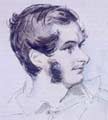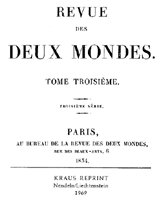Prosper Mérimée's novella Carmen is one of many manifestations of the 19th-century European fascination with the foreign and the exotic.
The setting of the story in Andalusia (in southern Spain) creates a colourful backdrop for the focus on the clash of cultures between Europeans and Gypsies, an ethnic group that was widely despised in the public sphere but romanticized by the popular imagination and the arts.
The encounter with difference - leading to both attraction and violences - is a theme that Mérimée explores on many levels in Carmen.
The title and the plot imply that the novella revolves around the story of Carmen and Don José, both members of minority populations, Gypsy and BASQUE, that were marginalized in Spain.
 |
| Prosper Mérimée |
However, Carmen is also a narrative of adventures abroad experienced by the French narrator who recounts the tale, a scholarly traveler whose erudition, ironic detachment, and well-informed outsider's perspective on Spain suggest a resemblance to none other than Mérimée himself, a learned civil servant and academician who traveled widely for his work and his research on architecture and history.
Mérimée's six-month trip to Spain in 1830 initiated a lifelong friendship with the aristocratic Montijo family, including the daughter,
Eugenia,
who married Emperor Napoleon III of France in 1853.
Carmen apparently originated in an incident recounted to Mérimée in 1830 by her mother, the Countess Montijo, nee Maria Manuela Kirkpatrick.
Kirkpatrick was living in Paris by the time Merimee published his "Carmen".

Carmen blends the genres of travelogue, adventure story, and romantic novel in an intriguing hybrid of fantasy and nonfiction.
Mérimée first published Carmen in 1845 in the predominantly nonfiction journal Revue des deux mondes, without any indication that it was a novella rather than a travelogue like his four Lettres d'Espagne ("Letters from Spain") of 1831-33.
The narrator's classical allusions and eye for details of topography, local customs, and language endow the narrative frame with an aura of realism, and his agency (aiding Don José's flight from justice, succumbing to Carmen's charms) obscures the boundary between the frame and the central plot.
Enhancing the implicit but ambiguous alignment of the narrator with the author, in the second edition of 1847, Mérimée added a fourth chapter that consists entirely of scholarly discourse on the Gypsies, their physiognomy, customs, and language.
The speaker in this curious text betrays no emotional involvement in his subject, unlike the traveler-narrator of chapters 1-3, who expresses considerable interest in and sympathy for the plight of Don José.
Mérimée's decision to shift the conclusion of the story from Don José's words absolving himself of responsibility for the fate of Carmen:
'The Calé are to blame, for bringing her up as they
did.'
to the narrator's philological reflections reinforces the central importance of language in the novella, which begins with a misogynistic Greek epigram:
Every woman is as bitter as gall. But she has two good moments:
one in bed, the other in death.
and ends with an enigmatic Romany proverb:
A closed mouth, no fly can enter.
While the narrator sprinkles his account liberally with linguistic erudition, only Carmen masters the art of language as persuasion, using Basque, Romany, and Spanish to manipulate those around her.
Her name, from the Latin carmen, which can mean a song, poem, or magic spell - appropriate for a character associated with song, dance, and seduction as well as with "Gypsy magic."





No comments:
Post a Comment